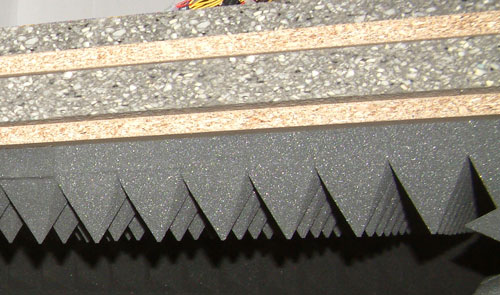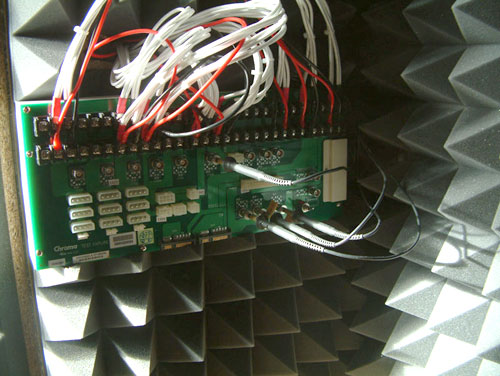Testing with the Chroma ATE Programmable Load

Our test equipment consists of two Chroma programmable DC Loads that enable us to test power supplies with an output of up to 1500W. The biggest advantage of the Chroma DC Loads is simply the high precision it provides. It can measure differences as small as 0.001V and 0.0001A, which will provide us with best-in-class results.
When programming the Chroma with specific amounts of load calculated according to the ATX norm, we are able to load power supplies to an exact percentage. We can now show results at every specific percentage needed. To get the best overview of a power supply, we load each unit with 10%, 20%, 50%, 80%, 100%, and 110% of the specified output. This is easy to calculate for a 1000W power supply: the 10% load is 100W and 110% load is 1100W. Remember that this is the amount of power the PSU delivers; due to inefficiencies, a power supply will actually draw more power from the wall.
Note: If you would like to know more about our testing methodology, equipment, and environment, please read our PSU testing overview.
We have added an additional 10% on the highest load to see how the units perform with overload. This test will be performed in all future reviews. The overload test is performed at room temperature as well as under more stressful conditions; to ensure we are not too cruel to the power supplies, we will keep the ambient temperature at 50°C in the stress test. Experience shows that many units can stand the overload at room temperature but will experience problems with higher temperature and overload together. Only the best-built units will survive this.

The Testing Environment
There is one flaw in testing power supplies with programmable loads while trying to measure the sound pressure levels at the same time. Because the programmable loads get very loud, there is no chance to even hear the power supply on the test stand. In order to make accurate measurements of the noise levels we needed a way to separate the test unit and the programmable loads. Our solution was to build a very thick box around the unit.

We concluded that a five-layer box with a total thickness of 6" (15cm) containing two layers of wood and three layers of special foam would suffice. It is designed as a box within a box. The inner box does not touch any part of the outer box, making it difficult for acoustic noise to pass through in the form of vibration. Each box is isolated on both sides with a layer of heavy foam that is normally used to insulate engines. On the inside we have an additional layer of 4" (10cm) thick pyramidal foam on every side of the box to eliminate the acoustic waves coming from the test object as well as we can.

To ensure a completely closed system we installed the printed circuit board that the connectors of the power supply are attached to inside the anechoic room/box. In other box designs, you would need to put all the cables through the wall. Unfortunately, that would result in the inside of the box not being fully isolated anymore. Our design keeps everything that needs to be connected inside of the box and maintains isolation.










17 Comments
View All Comments
Gholam - Wednesday, April 30, 2008 - link
I set up a pair of Dell PowerEdge 2950 III servers last week, each one running a pair of Xeon 5410 CPUs (2.33GHz quad-core), 8x2GB FB-DIMMs, and a pair of 15k rpm SAS drives hooked up to a PERC6 - peak power draw registered by BMC has been 293W so far on one box, and 276W on the other.HOOfan 1 - Wednesday, April 30, 2008 - link
and how many graphics cards are you running?Gholam - Thursday, May 1, 2008 - link
None, but desktop systems aren't large banks of FB-DIMMs either, nor multiple quad-core CPUs or rows of 15k rpm fans. The most power-hungry graphics card today is well under 200W power draw. You really, really have to work to exceed 500-600W power draw on a modern computer.Powervano - Tuesday, April 29, 2008 - link
I like most of your reviews very much guys and I have a suggestion/wish for the future reviews.Can you test (if possible, of course) Inter-Tech CobaNitrox IT-7750SG PSU?
I would also like to see the tests of FSP Epsilon series PSU.
Christoph Katzer - Tuesday, April 29, 2008 - link
Epsilon has already arrived and will come soon. CobaNitrox might not be interesting for most readers since (I think) they're only available in Germany.Powervano - Tuesday, April 29, 2008 - link
Nice to hear about Epsilon. I have seen about 87-89% efficiency about Epsilon series on several web-sites and I would like to see professional tests about that PSU.Yes, CobaNitrox is only available in germany, but it comes relatively cheap compared to other high quality PSUs and it is very interesting does it offer same functionality as other PSUs in the same class do?
Christoph Katzer - Tuesday, April 29, 2008 - link
http://www.planet3dnow.de/artikel/hardware/netztei...">http://www.planet3dnow.de/artikel/hardw...etzteile...HOOfan 1 - Tuesday, April 29, 2008 - link
Another CWT....Powervano - Tuesday, April 29, 2008 - link
Good review, but not the same high quality one as I see here, at AnandTech...JarredWalton - Tuesday, April 29, 2008 - link
Note the author. ;) But of course, that's about a year and a half old.